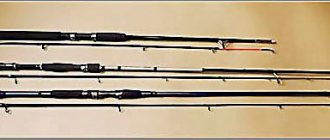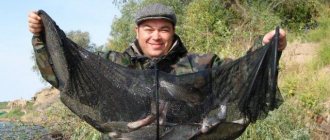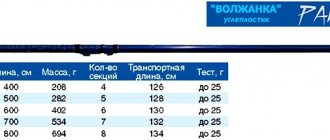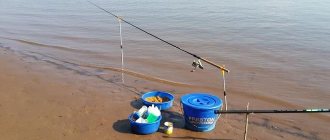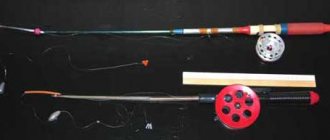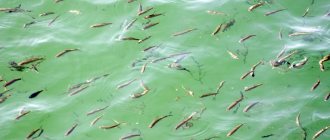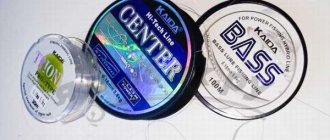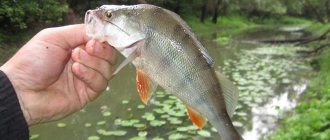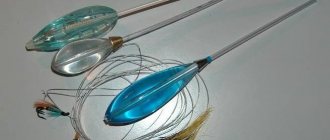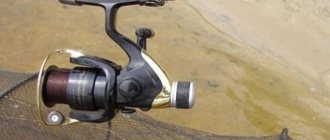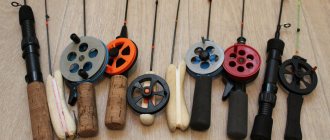Catching predatory fish is one of the most dynamic fishing methods. Therefore, many novice fishermen, looking at photographs of trophy specimens of pike or pike perch, are thinking of joining the ranks of spinning anglers, but do not know how to choose a spinning rod and how to start fishing with it. We will tell you about all the intricacies of choosing gear, its configuration and further most effective use in this article.
What is spinning
First of all, you need to answer this simple question: “What is spinning?” Spinning
is a type of fishing rod designed to catch predatory fish that respond to artificial baits set in motion by this rod.
The difference between a spinning rod and a simple fishing rod
is that spinning fishing is, first of all, an active search and further catching of fish by “playing with bait.”
The fisherman has to walk or travel long distances to find his trophy. The constant animation of the bait gives the fish the illusion of a real fish being hunted by predators. And the more realistic your artificial bait looks in the aquatic environment, the more desirable it will be for toothy and fanged fish. Depending on the time of year, day, and simply on changes in pressure, wind direction or other indicators, the fish chooses different feeding places relative to the bottom topography. It is for this reason that you have to do a lot of fishing with bait, fishing dumps, irrigation and channel holes. For such active fishing, special properties of the rod are needed, one of which is the low weight of the spinning rod compared to a fly rod. Also smaller in length, since a loaded bait is easier to deliver (throw) to the fishing point than a light hook with bait. Each time, choosing a different animation of the bait, we select our key to the fish in a specific place and time of fishing. And the diversity of representatives of the aquatic environment forces us to constantly adapt and look for “tasty” baits and baits. Spin rod. Agaru Blade Spin 210 Helios 1,855 for 1 piece. Spinning rod Tori Light Spin Helios 2,620 for 1 piece. Spinning rod River Stick 244 Helios 4,230 for 1 piece. Spinning rod Tenno Imperator Spin 270 Helios 1,870 for 1 piece. Spin rod. Agaru Blade Spin 240 Helios 2,070 for 1 piece. Plug rod Mangkhut 1.58m 2sec. 0.3-3g HI-DO 3,045 per 1 piece. Spinning rod Ninja Spin 240 DAIWA 3,345 for 1 piece. Spinning rod NOBLE Special 210 Cara NOBLE 1,650 for 1 piece. Spinning rod CROSSFIRE JIGGER 240 DAIWA 3,200 for 1 piece. Spinning rod CROSSFIRE SPIN 240 DAIWA 3,620 for 1 piece. Spinning rod Black Asteria 270 Helios 1,970 for 1 piece. Spinning rod Ninja Spin 210 DAIWA 3,080 for 1 piece. Spinning plug Ninja X LIGHT SPIN 2.10 m, 3-12 g 11627-210RU DAIWA 3,885 for 1 piece. Spinning rod NOBLE Spin 300 Cara NOBLE 2,910 for 1 piece. Spinning rod AZURA AZS-802 (244 cm) ZETRIX 4,570 for 1 piece. Spinning rod NOBLE II Spin 240 Cara NOBLE 5,280 for 1 piece. Spinning rod NOBLE II Spin 230 Cara NOBLE 4 125 for 1 piece. Rod Pro Force 248 Hearty Rise 16,480 for 1 piece. Spinning rod NOBLE II Spin 300 Cara NOBLE 6,270 for 1 piece.
Spinning rod or fishing rod?
So, which is better, a spinning rod or a fishing rod?
Fishing with a fishing rod is less active; for fishing with it, the main thing is to find your “catchy shore”, feed the peaceful fish and it will come, pleasing your eye with a sinking float. A floater sitting on a chair rarely understands why he should run somewhere in search of his, maybe even his only, bite. But catching a peaceful fish cannot compare with the drive and rush of adrenaline when a predator strikes, when each of its jerks is reflected in the hand through the rod blank. Spinning, compared to a simple fishing rod, is more sensitive, this is another of its features. I suggest you try it yourself and answer this eternal question yourself - “Which gear is more interesting to fish with?”
How to choose the right spinning rod
You can, of course, try to choose a “universal” spinning rod, say, 2.4 meters long with a bait test of 5-25 grams. Many people, including myself, started with universal tackle, but in the end came to the conclusion that a fisherman’s arsenal should include several specialized rods that are best suited for certain fishing conditions.
First, let's figure out what a “universal” spinning rod with the above characteristics is. Its length – 2.4 meters – will allow you to fish comfortably both from the shore and from a boat. But this comfort will be relative, because for a boat there is nothing better than a spinning rod with a height of 1.8-2.1 meters, and for the shore - 2.7-3 meters.
The 5-25 gram test will allow you to throw all types of baits: spinners, spinners, wobblers, jig baits. However, light baits (for example, spinners numbers “00”, “0” and “1” according to the Mepps classification) will not fly far enough, especially if the casting technique is not “set”, and you are unlikely to feel them when retrieving. And with heavy baits (for example, jig heads weighing 20 grams or more), you risk overloading the spinning rod, which will ultimately lead to its breakdown.
The conclusion can be drawn as follows: lovers of the “universal” will still have to make a compromise, and even a spinning rod “for all occasions” has its own “area of action”.
Thus, before buying a spinning rod (or even asking advice from experienced colleagues on the forum), decide in what conditions you plan to fish most often. Answer the following questions:
- What kind of body of water will it be: a deep river with a current or a stagnant bay, a shallow lake or a reservoir?
- Will fishing be done from a boat or from the shore?
- What kind of fish and what size do you plan to catch?
- Perhaps you have already decided on the type of bait? In this case, the spinning rod should be chosen for them. For example, one model is suitable for jig fishing, a completely different one for oscillating spoons, and a third for jerkbaits.
Now is the time to decide what parameters you should pay attention to when choosing gear. There are three of them: the length of the rod, its action and the lure test.
Everything should be clear with the length; in most cases it ranges from 1.8 to 3 meters.
Coil selection
The spinning reel is the second most important part of the spinning tackle. The casting distance, the quality of the bait, the success of landing fish and the comfort of fishing in general largely depend on its quality.
Before choosing a spinning reel, you need to decide what they are:
- spinning reels;
- inertial coils;
- cartoon models.
Spinning reels are the most popular type, becoming widespread due to their ease and ease of use. This type is the optimal spinning reel for a beginner.
Inertial reels, in which the drum rotates when casting, have practically fallen out of use in spinning fishing. Their advantages - simplicity, reliability and maximum sensitivity - are offset by their disadvantages - the inability to cast light baits, the tendency to form “beards” and some difficulty in mastering the casting technique.
Multiplier reels are also inertial in nature, however, their difference is that due to the presence of a gearbox, there are several revolutions of the spool per revolution of the handle. Multiplier reels are suitable for all types of spinning fishing except ultralight, but their main niche is fishing in methods that subject the tackle to high loads - heavy jigs, fishing with jerkbaits and large wobblers.
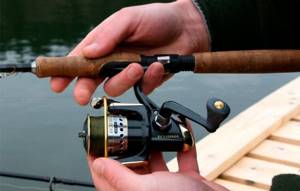
There are several types of these devices
Selecting the material from which the spinning rod is made
Fiberglass. The advantages of fishing rods made from fiberglass are their relative cheapness and unpretentiousness, that is, they do not require special care. But their main disadvantage is their large mass. If you actively fish using a fiberglass rod, your hand will get tired very quickly. Spinning rods made of fiberglass can only be used for trolling, where frequent casting of bait is not required.
Composite Composite spinning rods have average rigidity. The composite is created when fiberglass fibers are added to carbon fibers. I advise you to purchase spinning rods made of composite only if you cannot afford to purchase a carbon fiber rod. At the moment, a huge number of relatively inexpensive carbon fiber rods have appeared in markets and stores, from which you can choose a good spin.
Carbon fiber, carbon fiber, graphite, carbon are the same thing. The lightest in weight are spinning rods made of carbon fiber. I advise you to choose from this material.
Carbon fiber backs vary in modulus of graphite content M1, M2, M3, etc.
The smaller the module, the greater the flexibility and the longer the vibrations of the spinning tip die out, and this, in turn, negatively affects the casting distance and reduces the reaction speed of the rod. But you shouldn’t get carried away with large modules. More carbon fiber means more rigidity, but also more fragility.
I have quite often come across statements on the Internet that rods with “coal” content modules greater than six in cold weather, especially at sub-zero temperatures, become more fragile and can break. Personally, my friends and I have not encountered this, but such an opinion exists, of course it’s up to you to decide. I advise you to choose from rods with, in my opinion, optimal carbon fiber content modules of five and six (M-5, M-6).
Which spinning rod test should you choose?
The test is a spinning indicator that determines the lower and upper weight limits of the artificial baits used. When choosing a spinning rod, you need to decide what weight the artificial bait you will use when fishing will be. The lower test is the minimum value of the mass of the bait. In simple terms, if the weight of the bait is equal to the value of the lower test, then when retrieving such a bait you will feel its play with the rod, and if the weight of the bait is less than the value of the lower test, then when retrieving, you will not feel the play of the bait with the spinning rod.
The lure test (or just test for short) is the most important characteristic of a fishing rod. Shows the weight range within which the baits used must fit. The upper limit of the test is the permissible weight limit, systematically exceeding which, sooner or later you will break the rod. The lower limit is the minimum weight of the spinner (or jig head, or wobbler), which is able to load the spinning rod so that it “works” and, roughly speaking, serves as a “catapult” when casting. However, remember that the manufacturer does not always honestly, to the nearest gram, indicate the test of the rod, especially the lower one.
For example, a test of 1-5 grams means that the spinning rod is “sharpened” for the lightest baits. However, this does not make it impossible to catch large fish with it. It will just take longer to fish it out, and a well-tuned friction brake of the reel will help to avoid breakage during strong jerks.
The upper value of the test is the maximum weight of the bait that can be cast with this rod without the risk of breaking it. In terms of the weight of spinning rods used for casting baits, there are ultra-light ones, with a dough of 1-5 g, light 5-15 g, medium 7-25 g, heavy 20 or more grams, but this is all approximately. There are such rods on which, instead of a test, a range of recommended fishing lines for breaking load is printed. For catching small and medium-sized fish, as well as for the thrill of fishing, I recommend a spin with a dough of 0-10 g. My personal opinion is that this is a bit of overindulgence. In addition, such a fishing rod requires delicate care. For catching medium-sized fish on small rivers and lakes, a rod with a test weight of 5-25 g is suitable. The thrill of fishing with such a spinning rod is very excellent. And for medium and large bodies of water, if you need to cast long-distance baits of decent weight, a spin with a dough of 20 g or more is suitable. For trolling you need sticks with large dough, starting from 60 grams.
Selection of fishing line and leashes
In modern fishing, three types of fishing lines are used:
- Monofilament is an ordinary fishing line, the advantages of which are low cost, transparency and invisibility in water. High elasticity, i.e. the ability to stretch, can be both an advantage and a disadvantage. Thanks to this property, the line absorbs fish jerks well, but at the same time does not provide the sensitivity necessary for many types of fishing. The disadvantage of monofilament lines is the memory effect of the material - when wound on a reel, it comes off as a spiral, which reduces the casting distance and can also lead to the formation of a “beard”.
- Braided fishing lines are the most durable, have almost no stretch, which ensures maximum contact with the bait, have no memory, but are quite expensive, and if loops and knots form, it is very difficult to untangle them.
- Fluorocarbon fishing lines are almost invisible in water, having a refractive index close to it, low elongation, but their main advantage is their high resistance to abrasive influences. The disadvantage of fluorocarbon is that it has lower tensile strength than even conventional monofilament fishing line and a relatively high price. Fluorocarbon fishing lines are used in the manufacture of leashes. It is not advisable to use them as the main fishing line.
Before choosing a spinning line for a beginner, it is important to understand that the choice of fishing line depends on the conditions and method of fishing. In most cases, it is better to use braided line. It only makes sense to choose a monofilament for fishing at short distances or with lures that twist the line strongly.
For beginners, it is better to use braided fishing line, and monofilament fishing line is optimally used in the process of learning to cast, during which the formation of beards and, accordingly, damage to the fishing line is inevitable.
Read more
How to repair a spinning rod with your own hands?
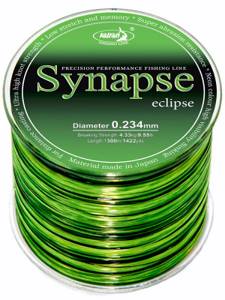
Many people stick to the first option - spinning braid
How to choose a spinning rod system
Spinning rods differ in such indicators as action. The tuning can be fast, medium and slow. A fast action is when, when the rod tip is loaded, the upper third or quarter of the spin tip bends (works). For medium action rods, the upper half works when under load. Otherwise, such a spin is called a semi-parabolic spin. For slow ones, the deflection is three quarters of the total length of the whip; in another way it is also called parabolic.
The action of a rod is how it bends under load. A slow-action spinning rod (“parabolic”) bends from the butt (handle) itself when casting and during retrieving. It is absolutely not suitable for fishing with jigs, wobblers and jerkbaits. However, if you are going to specialize exclusively in “turntables” and “oscillators,” then this is perhaps the best option. All other things being equal, casting with a “slow” spinning rod goes farther, and when fishing from the shore this factor plays one of the first roles.
In spinning rods with fast or ultra-fast action (“fast” or “extra fast”), the upper third bends under load. Rigid and sensitive, such a rod is used when fishing with jigs (classic “stepped” wiring) or minnow wobblers (jerk wiring – “twitching”). At the same time, in order to achieve the greatest casting distance, the bait should be sent sharply, bitingly (you may have to work out the appropriate casting technique).
A medium action spinning rod (“semi-parabolic”) is something intermediate between the types given above, with a claim to versatility.
Selection of baits
The range of spinning lures is very large and continues to constantly expand.
- oscillating spoons - despite the fact that these lures have gone out of fashion, they continue to attract fish, and in some conditions they are the best choice;
- rotating spoons are the best option for a novice fisherman, since the fishing technique with them is extremely simple;
- wobblers - distinguished from each other by the method of wiring: cranks, which have their own active game, lead evenly or with stops, minnow wobblers are suitable for twitching - jerking wiring;
- In most cases, silicone baits are used for jig fishing, equipped with a jig head or a “eared” sinker with a hook. This is one of the most popular types of bait due to its effectiveness and low cost.
Other baits - spinnerbaits and buzzbaits, topwaters, jerks, cicadas, tailspinners and others - are quite specific, are usually used in certain conditions and often require not only special wiring, but also the use of special gear. Based on this, we should not recommend them to beginners.
General recommendations
In the store, pay attention to the following: the rod whip should be straight and without cracks. All rings and the spool holder axle must be on the same straight line. The rings fit tightly, the resin is without cracks, the inserts in the rings should be smooth and not rotate. The nut for attaching the reel to the rod should rotate easily. It is advisable to try to install the coil intended for use and see that when the nut is well tightened, the coil is well secured and does not dangle. Not all markings on a spinning rod should be trusted, especially if you do not purchase the rod from a company store.
In conclusion, I will give a few typical situations that will help novice fishermen navigate the choice of gear.
- Fishing from the shore on a large river (width more than 100 meters) for medium and large fish (pike, perch, pike perch) - spinning rod 2.7-3 meters long, fast or extra fast action, test 7-28, 10-30, 15- 45 grams, baits – jig heads, spoons, wobblers 12-28 grams.
- Fishing from the shore on a small river (10-30 meters) for small and medium-sized fish (pike, perch, chub, ide, grayling) - spinning rod 2.1-2.4 meters long, fast or extra fast action, test from 1-5 up to 4-16 grams, baits – light spinners, wobblers, jig heads.
- Fishing from a boat on a lake or pond without a current - spinning rod 1.8-2.28 meters long, medium, fast or ultra-fast action depending on the type of bait, test 3-12, 4-16, 5-20 grams
- Fishing from a boat on a large river and at great depths for large pike and pike perch - spinning rod 2.1-2.4 meters long, fast or extra fast action, weight from 10-30 to 20-50 grams, bait - large wobblers (10-15 cm), jig heads (18-36 grams)
- Fishing on the lake from the shore or from a boat with minnow wobblers (twitching) - spinning rod 1.8-2.1 meters long, extra fast action, test from 1-7 to 3-14 grams (wobblers up to 3-7 cm), from 3-14 to 5-21 grams (wobblers up to 10 cm), from 5-25 to 7-28 grams (large wobblers - 10-13 cm).
The recommendations given are approximate and may deviate in one direction or another (depending on the conscious preferences of the fisherman, as well as specific circumstances: the depth of the reservoir, the strength of the current, the clutter of the bottom, the distance from the shore of holes, edges and dumps, the likelihood of catching a large trophy, etc.). etc., etc.)
Source
